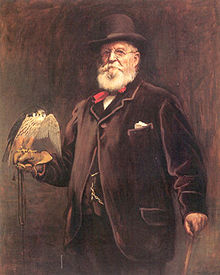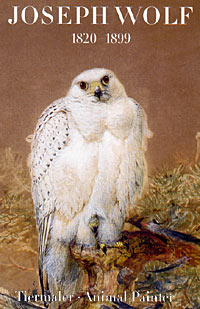Joseph Wolf
Joseph Wolf (born January 22, 1820 in Mörz , today's district of Münstermaifeld ; † April 20, 1899 in London ), also Josef Mathias Wolf , was a German-English animal painter .
Life
Joseph Wolf was born on January 22nd, 1820 as the son of a farmer in Mörz. Even as a child he showed an extraordinary talent as a draftsman and painter. Wolf was trained as a lithographer in the Koblenz lithographic printing house of the brothers Josef and Franz Xaver Becker and then got in touch with Eduard Rüppell (1794–1884) in Frankfurt am Main, who had just returned from Africa and was looking for an illustrator for his work on the birds of Northeast Africa . Rüppell was enthusiastic about the young man's abilities and put him in charge of Johann Jacob Kaup (1803–1873), the director of the Grand Ducal Natural History Cabinet in Darmstadt. Here Wolf attended art classes from the academy director Carl Ludwig Seeger (1808–1866), and earned his living as a lithographer. On Kaup's recommendation, Wolf received his first illustration orders from the ornithologist Hermann Schlegel (1804–1884), who at that time was working as a curator at the Reich Museum for Natural History in Leiden , Holland . After he exceeded all expectations with this work, Schlegel commissioned him to produce the panels of his Trait de Fauconnerie (published 1845). of the largest and most beautiful falcon book that has ever appeared. In the meantime the attention of the young wolf had also become known in London, the then center of natural history. In the autumn of 1847 he was invited by David William Mitchell (1794-1859) to work on George Robert Gray's (1808-1872) Genera of Birds in London. On March 20, 1848, Wolf traveled with the "Soho" to England, where he quickly developed into the most important animal painter of his time.
There is hardly a table published on this side or the other side of the Atlantic in which Wolf was not involved. In addition to scientific illustrations, Wolf also created a wealth of paintings that are still in public and private collections. Although Wolf maintained his ties to his old homeland and traveled to Germany several times, he was almost completely forgotten in this country. On the occasion of the 100th anniversary of his death, the long overdue retrospective was prepared, which opened in the Biohistoricum in Neuburg an der Donau on June 29, 2000. Following Wolf's life, the exhibition was then shown in the Hessisches Landesmuseum in Darmstadt, in the Nationaal Natuurhistorisch Museum (Naturalis) in Leiden and in the Natural History Museum in London.
Joseph Wolf is often referred to as the most important animal painter of the 19th century . He was praised for his inimitable ability to bring the animals in his pictures back to life from dead preparations.
Honors
In honor of Joseph Wolf, a new street was named after him in his birthplace Mörz in 2002.
gallery
literature
- Karl Schulze-Hagen, Armin Geus (ed.): Joseph Wolf (1820–1899) - animal painter. Exhibitions in Neuburg and London. Basilisken, Marburg an der Lahn 2000, ISBN 3-925347-57-7 .
- Nicole Ricarda Sußet: Liveliness in the picture. Joseph Wolf and animal painting in the 19th century , Basilisk-Presse in Natur + Text Verlag, Rangsdorf 2013, ISBN 978-3-941365-209 .
- Gisela Bohnstedt-Hannon: Der Vogelnarr , Rhein-Mosel-Verlag, Zell 2020, ISBN 978-3-89801-236-2 .
Web links
- Literature by and about Joseph Wolf in the catalog of the German National Library
- Kurzbiographie (English)
- Homepage of the Münstermaifeld-Mörz district
| personal data | |
|---|---|
| SURNAME | Wolf, Joseph |
| ALTERNATIVE NAMES | Wolf, Josef Mathias |
| BRIEF DESCRIPTION | German-British animal painter |
| DATE OF BIRTH | January 22, 1820 |
| PLACE OF BIRTH | Mörz (Münstermaifeld) |
| DATE OF DEATH | April 20, 1899 |
| Place of death | London |





